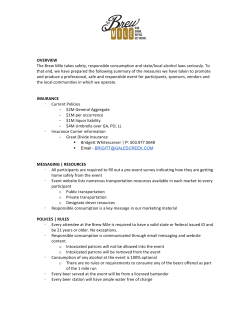
MBI Municipal Workshops
MBI Municipal Workshop April 2015 Becket Ashfield New Salem Workshop Agenda Workshop Goal: Engage in productive dialogue over Last Mile initiative and town objectives, questions, concerns. Program Overview Roles & Responsibilities MBI Municipalities/MLPs Private Sector Anticipated Project Types Regional FTTP Network through a municipal cooperative (e.g. WiredWest) Regional FTTP Network with municipal RFP for operator/enterprise partner Independent municipal build with enterprise partner Design, Construction & Program Management Grant Application Process & Planning Grants Open Conversation & Next Steps 2 Last Mile Program Overview Last Mile Program Goal: Partner with towns to extend broadband service in every unserved community. Build a sustainable, state-of-the-art network cost-efficiently and professionally. Extend broadband service in high-cost towns with existing cable providers. 3 Last Mile Program Overview Progress To-Date: $50 million secured from Legislature and Governor Baker. Cable/Broadband Workshop held 3/5/15. Construction model of 44 town pure fiber network. Premise counts/mapping of all unserved and cable towns. Municipal assistance program with FRCOG on borrowing, warrants. MBI ready to launch grant process & next steps. 4 Roles & Responsibilities: MBI MBI’s role is to provide state support (financial and otherwise) for municipal projects extending broadband service to town residents. Grant administration and management of state funds. MBI expertise to assist towns selecting broadband options. Transparency to the public and municipalities. No MBI ownership of Last Mile network. MBI Services & Support to Towns can Include: Technical assistance, legal advice & consultation. Project management, design & construction for regional network. RFQ/RFPs for design & engineering, construction, operators & ISPs. State grants to reduce town costs for Last Mile construction. 5 Roles & Responsibilities: Towns & MLPs Decide what, if any, Last Mile solution is right for its residents. Make decisions regarding network build, and issues of costs, ownership, and operations. Commit to town share of project costs. Towns have through June 2016 to vote – MBI will maintain each town’s share of state funding for qualifying projects. Towns May Choose To: Partner through a municipal cooperative (e.g WiredWest) to develop & operate a regional network. Seek private sector partners for its network build or for an operator or ISP. Seek alternative technologies (to fiber) for service in its town. Request assistance from MBI. 6 Roles & Responsibilities: Private Sector Private vendors and contractors can be involved in the Last Mile, from design, construction and project management, to potentially including the network operator and ISP. Towns need to: Following legal and prudential requirements for procurement (RFPs). Review legal agreements for enterprise partners. Protect themselves on issues of network solvency, ownership, operational costs and other issues. MBI can help. 7 Program Assumptions Estimated cost $112-119M. Desktop modeling performed for all cost estimates. Modeled costs are based on a GPON-FTTP build across 44 towns. Residential services can include Data-Internet, Voice & Video-TV. Alternatives to fiber-only based on town request. Project complexity requires strong program management. 8 GPON-FTTP Model: Network Architecture For our network model we applied an architecture consistent with Fiber-ToThe-Premise best practice deployments. Core Network Distribution Network Local Network Aerial Cable (Unarmored) NAP Multiport Hut 144F Cabinet OLT POI Optical Line Termination Network Components Core Network POI: • Connect Cost • Backhaul and redundancy Fiber: • 12F Cable • Core Network Labor Underground Cable (Armored) Distribution Network Hut: • Construction (w/ components) • Environmental • Permitting Fiber: • 12F Armored Cable • 12F Unarmored Cable OverLashing to MBI123 Network Drop Optical Network Terminal 12F-144F Fiber Manhole Vault Local Network Cabinet: • 144F (w/ components) Fiber: • 12F-144F Armored Cable • 12F-144F Unarmored Cable NAP: • 4-port Multiport • 8-port Multiport • 16-port Multiport OverLashing to MBI123 Network Drop Optical Network Terminal Fiber: • 2F Drop Cable • Drop Installation Labor Broadband Modem Video CPE Driveway Length 9 Work Breakdown: “Pure Fiber” Scope Items/Tasks Last Mile Pole Count 62,000 Fiber Miles 2000 POI / Network Hut Customer Premises 44 26000 Executing the Project: Utilize Design-Bid-Build Process Stakeholders: State, Towns, WW, Private Sector, & Utilities Functional areas and procurements; OPM, Design-Engineer, Construction Firm(s) & Systems Integrator Tight controls on the Pole Application & Make Ready process Create logical & geographic areas : “Zones & Clusters” 10 Construction Zones & Clusters Monroe Florida Rowe Heath Colrain Leyden Warwick Royalston Charlemont New Ashford Savoy Hawley Hancock Lanesborough Windsor Plainfield Leverett* Cummington Hinsdale Alford Egremont Petersham Princeton New Braintree Becket Worcester Tyringham Monterey Otis Blandford Montgomery Sandisfield Mount Washington Shutesbury New Salem Worthington Chesterfield Middlefield Washington West Stockbridg e Goshen Peru Wendell Ashfield New Marlborough Tolland Springfield Benefits: Drives down cost of mobilization. Develops logical work groups for Make Ready work activities. Run parallel projects with multiple construction companies. 11 Scope of Work for Major Procurements Project Management Vendor management and third party rights License applications Permitting Design and Engineering Cost accounting Construction management Construction Bid packages Field supervision Acceptance process Construction Firm(s) Systems Integrator Preliminary Design of Network Architecture Installation of all Fiber Huts Commissions Network into Service Conduct Detailed Engineering Study to confirm project costs Integration of Fiber into Middle Mile and Backhaul connectivity QA/QC all Construction work Equipment Manufacturer Selection (via RFP) and Product Compliance Installation of all Strand and Fiber and Equipment (OSP) Commission End User Services 12 Design Considerations Town Participation & Premise Count Network Architecture GPON, XPON Versus Active Ethernet 100% Premise Coverage Versus Pre-Subscription IPVideo - TV Versus Other-the-Top (OTT)-Streaming Designing by Adjacent Town Population Centers Pole Licensing & Asset Ownership Agent Relationship with Multiple Attachment Agreements Overlashing & Leasing Rights Transferring Ownership 13 Construction Timeline: “Cluster Example” Construction Timeline Factors: •A 30-month duration to complete each 10,000~ pole construction cluster. •6 – 9 towns per construction cluster. •The initial town approval date, which determines cluster assignment. Ready for Service Systems Integration and Commissioning Construction Final Design & Procurement Make Ready Initial Town Approval Month 1 Month 14 Month 30 Month 29 Month 28 Month 16 Timeline Assumptions: • Clusters will be staggered to minimize gridlock (90 days). • Cluster scheduling takes into account: geography, population, utility capacity, and preliminary design completion. • Avg. pole span is 180’. 14 Last Mile Construction Timeline 2015 2016 2017 2018 2019 2014 State Allocates $50M Construction Cluster 1 OPM RFP Community Outreach: Establishing Priorities OPM Selected Construction Cluster 2 Design Firm Selected Construction Cluster 3 Construction Cluster 4 Construction Cluster 5 Pole Survey Apps & Make Ready for Clusters 1 & 2 (10-18 towns) Pole Survey Apps & Make Ready for Clusters 2 -3-4 (10-25 towns) Pole Survey Apps & Make Ready for Clusters 4 & 5 (20-44 towns) 15 Major Milestones Milestones Dates Select Board Resolution By December 31, 2014 Town Meeting Approves Bond Debt Rolling basis: Spring 2015 through Summer 2016 Owners Project Manager Selection Summer 2015 Engineer Firm Selection Summer 2015 Preliminary Design and Pole Survey Rolling basis: Fall 2015 through Winter 2016 Make Ready Process Rolling basis: Winter 2015 through Winter 2017 Construction Period Rolling basis: Fall 2016 - on 16 Grant Process: Why & Who Process Transparency Consistency & Equity Across Towns Fiduciary Responsibility Eligible Applicant(s) Town(s) MLP(s) MLP Cooperative 17 Grant Process: Allocation Allocation Model – $40 Million 18M Professional Services, Engineering & Legal 22M Make Ready & Construction Costs Initiative Types Scenario 1: Regional Network Project Scenario 2 : Independent Town Project 18 Grant Process: Eligibility Criteria Be one or more of the “unserved” towns. Propose a Last Mile deployment project to provide affordable, high-speed broadband access. Demonstrate capacity to operate, maintain and provide services or describe plan to obtain services. Demonstrate a commitment to fund town costs of the project (beyond state grant amounts or enterprise investments). 19 Last Mile Broadband Services Grant Solicitation Solicitation Description Application Introduction Approach to Project Implementation Approach to Operations and Service Provider Legal Compliance and Authority Agreement(s) 20 Broadband Planning Assistance Grant Solicitation Eligible Applicant(s) Town(s) MLP(s) MLP Cooperative Amount - $5,000 per Town Uses Planning Preliminary Marketing Feasibility Legal & Financial 21 Grant Timing Last Mile Broadband Services Grant Solicitation: Release of final Grant Solicitation mid-May 2015 See released Grant Solicitation for final dates (rolling basis) Last Mile Broadband Planning Assistance Grant Solicitation: Release of final Grant Solicitation mid-May 2015 See released Grant Solicitation for final dates (rolling basis) 22 Questions & Discussion
© Copyright 2025












